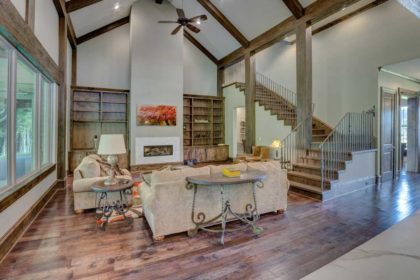
If you are considering updating your flooring and are on the hunt for something that’s long-lasting, you may want to consider engineered wood flooring. It has the look (and sometimes even feel) of solid wood floors with the durability of laminate. If you have lots of kids or pets running around your house, you’ll love a good quality, engineered wood floor!
We are often asked how much engineered wood costs. It can be less expensive than solid wood, but premium collections with thick top layers and advanced durability can have price tags similar to solid wood. Plan for anywhere between $6 and $15 per square foot for a quality material.
Engineered wood flooring comes in a variety of wood species, such as: Oak, maple, hickory, birch, cherry, walnut, and even exotic woods like African mahogany and tiger wood. It is also available in a variety of widths – slim to wide plank, and it offered with specialty looks like hand-scraped or multi-tone. Engineered wood flooring is also available in different thicknesses which makes it easy to match the height of existing adjoining flooring.
Be wary of the thinner engineered wood flooring and try to pick a product with a thicker ‘wear layer’. The wear layer is made of solid wood and can be anywhere from 2 to 6 millimeters thick. The thicker the wear layer, the better, and a thicker wear layer typically indicates a more premium product that is made to last. Another plus to having a product with a thicker wear layer is you will be able to sand and refinish the floor if needed.
Another thing to note with wood flooring – both solid engineered wood – wood is more prone to damage from flooding and standing water. It may not be the vest choice for bathrooms, laundry rooms, or basements where flooding is an issue.
On the bright side, engineered wood is more stable than solid wood and is less likely to expand, contract, or shift when exposed to moisture, humidity, and temperature shifts. It is also less likely to warp over time. To maintain your floors, simply vacuum or sweep daily and mop with a cloth dampened with water, but always follow the recommendations from your manufacturer.
Should you have additional questions about replacing the flooring in your home, feel free to contact us, we are happy to help you!